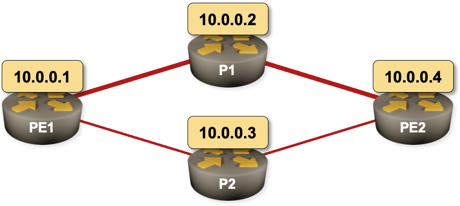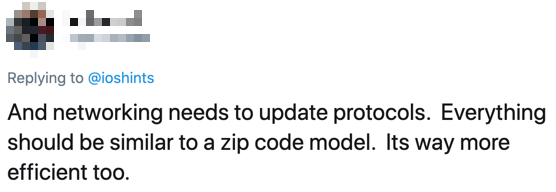Category: networking fundamentals
Video: Multi-Layer Switching and Tunneling
After discussing the technology options one has when trying to get a packet across the network, we dived deep into two interesting topics:
- How do you combine packet forwarding at multiple layers of OSI stack (multi-layer switching)?
- What happens when you do layer-N forwarding over layer-M transport core where N <= M (example: IPv6 packets over IPv4 packets) aka tunneling?
You’ll find more details (including other hybrids like Loose Source Routing) in Multi-Layer Switching and Tunneling video.
IBGP, IGP Metrics, and Administrative Distances
TL&DR: If you run multiple IGP protocols in your network, and add BGP on top of that, you might get the results you deserve. Even better, the results are platform-dependent.
One of my readers sent me a link to an interesting scenario described by Jeremy Filliben that results in totally unexpected behavior when using too many routing protocols in your network (no surprise there).
Imagine a network in which two edge routers advertise the same (external) BGP prefix. All other things being equal, it would make sense that other routers in the same autonomous system should use the better path out of the autonomous system. Welcome to the final tie-breaker in BGP route selection process: IGP metric.
What Exactly Happens after a Link Failure?
Imagine the following network running OSPF as the routing protocol. PE1–P1–PE2 is the primary path and PE1–P2–PE2 is the backup path. What happens on PE1 when the PE1–P1 link fails? What happens on PE2?

Sample 4-router network with a primary and a backup path
The second question is much easier to answer, and the answer is totally unambiguous as it only involves OSPF:
Learning Networking Fundamentals at University?
One of my readers sent me this interesting question:
It begs the question in how far graduated students with a degree in computer science or applied IT infrastructure courses (on university or college level or equivalent) are actually aware of networking fundamentals. I work for a vendor independent networking firm and a lot of my new colleagues are college graduates. Positively, they are very well versed in automation, scripting and other programming skills, but I never asked them what actually happens when a packet traverses a network. I wonder what the result would be…
I can tell you what the result would be in my days: blank stares and confusion. I “enjoyed” a half-year course in computer networking that focused exclusively on history of networking and academic view of layering, and whatever I know about networking I learned after finishing my studies.
Video: Should You Build or Buy a Solution?
After figuring out what business problem you’re trying to solve and what the users expect to get from you it’s time for the next crucial question: should you buy a shrink-wrapped product/solution or build your own? I addressed that question in the third part of Focus on Business Challenges First presentation.
Not surprisingly, the same dilemma applies to network automation solutions, and is often the source of endless time-wasting discussions that I really should have stopped engaging in, but sometimes duty calls ;)
Chasing CRC Errors in a Data Center Fabric
One of my readers encountered an interesting problem when upgrading a data center fabric to 100 Gbps leaf-to-spine links:
- They installed new fiber cables and SFPs;
- Everything looked great… until someone started complaining about application performance problems.
- Nothing else has changed, so the culprit must have been the network upgrade.
- A closer look at monitoring data revealed CRC errors on every leaf switch. Obviously something was badly wrong with the whole batch of SFPs.
Fortunately my reader took a closer look at the data before they requested a wholesale replacement… and spotted an interesting pattern:
Video: Know Your Users' Needs
After explaining why you should focus on defining the problem before searching for a magic technology that will solve it, I continued the Focus on Business Challenges First presentation with another set of seemingly simple questions:
- Who are your users/customers?
- What do they really need?
- Assuming you’re a service provider, what are you able to sell to your customers… and how are you different from your competitors?
Why Is OSPF not Using TCP?
A Network Artist sent me a long list of OSPF-related questions after watching the Routing Protocols section of our How Networks Really Work webinar. Starting with an easy one:
From historical perspective, any idea why OSPF guys invented their own transport protocol instead of just relying upon TCP?
I wasn’t there when OSPF was designed, but I have a few possible explanations. Let’s start with the what functionality should the transport protocol provide reasons:
… updated on Friday, November 20, 2020 15:10 UTC
How Fast Can We Detect a Network Failure?
In the introductory fast failover blog post I mentioned the challenge of fast link- and node failure detection, and how it makes little sense to waste your efforts on fast failover tricks if the routing protocol convergence time has the same order of magnitude as failure detection time.
Now let’s focus on realistic failure detection mechanisms and detection times. Imagine a system connecting a hardware switching platform (example: data center switch or a high-end router) with a software switching platform (midrange router):
New Content: Graph Algorithms – Flows and Connectivity
Last week we enjoyed the second half of Graph Algorithms lecture by Rachel Traylor, this time focusing on flow- and connectivity challenges.
After an easy start defining flows and walking us through various maximum flow algorithms, Rachel explained circulations and saturating flows, switched into high gear with (supposedly painless) intro to linear programming and minimum cost flow problems, and concluded with dynamic flows and using flows to explore graph connectivity.
You’ll need Standard or Expert ipSpace.net subscription to watch the videos.
Video: Getting a Packet Across a Network
After (hopefully) agreeing on what routing, bridging, and switching are, let’s focus on the first important topic in this area: how do we get a packet across the network? Yet again, there are three fundamentally different technologies:
- Source node knows the full path (source routing)
- Source node opens a path (virtual circuit) to the destination node and uses that path to send traffic
- The network performs hop-by-hop destination-address-based packet forwarding.
More details in the Getting Packets Across the Network video.
Appreciating the Networking Fundamentals
When I started creating the How Networks Really Work series I wondered whether our subscribers (mostly seasoned networking engineers) would find it useful. Turns out at least some of them do; this is what a long-time subscriber sent me:
How Networks Really Work is great, it’s like looking from a plane and seeing how all the roads are connected to each other. I know networking just enough to design and manage a corporate network, but there are many things I have learned, used and forgotten along the way.
So, getting a broad vision helps me remember why I chose something and maybe solve my bad choices. There are many things that I may never use, but with the movement of all things in the cloud it’s great to know, or at least understand, how things really work.
Parts of the webinar are accessible with free ipSpace.net subscription; you need one of the paid subscriptions to watch the whole webinar.
Grasp the Fundamentals before Spreading Opinions
I should have known better, but I got pulled into another stretched VLANs for disaster recovery tweetfest. Surprisingly, most of the tweets were along the lines of you really shouldn’t be doing that and that would never work well, but then I guess I was only exposed to a small curated bubble of common sense… until this gem appeared in my timeline:

Interestingly, that’s exactly how IP works:
New on ipSpace.net: Graph Algorithms
After a bit more than a year, we ran another math-focused webinar last week: Rachel Traylor came back to talk about graph algorithms, focusing on tree-, path- and center problems.
In her lecture you’ll find:
- maximum branching algorithms (and I couldn’t stop wondering why we don’t use them for OSPF- or IS-IS flooding)
- path algorithms including the ones used in OSPF, IS-IS, or BGP, as well as algorithms that find K shortest paths
- center problems (for example: where do I put my streaming server or my BGP route reflector)
You’ll need Standard or Expert ipSpace.net subscription to watch the videos.
Video: Bridging, Routing, Switching
If you’re working solely with IP-based networks, you’re likely assuming that hop-by-hop destination-only forwarding is the only packet forwarding paradigm that makes sense. That is not true; even today’s networks use a variety of forwarding mechanisms, most of them called some variant of routing or switching.
What exactly is the difference between the two, and what is bridging? I’m answering these questions (and a few others, like what’s the difference between data-, control- and management planes) in the Bridging, Routing, and Switching Terminology video.
